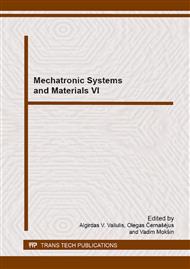[1]
H. Cho, Optomechatronic: Fusion of Optical and Mechatronic Engineering, CRC Press Taylor&Francis Group, (2006).
Google Scholar
[2]
H. Hosaka, Y. Katagiri, T. Hirota, K. Itao, Optomechatronics, Marcel Dekker, Inc., (2005).
Google Scholar
[3]
T. J. van Beek, M. Erden, T. Tomiyama, Modular design of mechatronic systems with function modelling, Mechatronics 20 (2010) 850–863.
DOI: 10.1016/j.mechatronics.2010.02.002
Google Scholar
[4]
T. R. Browning, Applying the design structure matrix to system decomposition and integration problems: a review and new directions, IEEE Transactions on Engineering Management 48(3) (2001) 292–306.
DOI: 10.1109/17.946528
Google Scholar
[5]
E. P. Hong, G. J. Park, Modular Design Method Using the Independence Axiom and Design Structure Matrix in the Conceptual and Detailed Design Stage, Daejeon, ICAD, 2011, p.134–141.
Google Scholar
[6]
H. Komoto, T. Tomiyama, Multi-disciplinary system decomposition of complex mechatronics systems, CIRP Annals – Manufacturing Technology 60 (2011) 191–194.
DOI: 10.1016/j.cirp.2011.03.102
Google Scholar
[7]
G. Pahl, W. Beitz, J. Feldhusen, K.H. Grote, Engineering Design, London Springer-Verlag, (2007).
Google Scholar
[8]
V. M. Athawale, S. Chakraborty, A TOPSIS Method-based Approach to Machine Tool Selection, Dhaka, IIEOM, (2010).
Google Scholar
[9]
C. P. Kiran, S. Clement, V. P. Agrawal, Coding, evaluation and optimal selection of a mechatronic system, Expert Systems with Applications 38 (2011) 9704–9712.
DOI: 10.1016/j.eswa.2011.01.171
Google Scholar
[10]
T. Yang, Ch-Ch. Hung, Multiple-attribute decision making methods for plant layout design problem, Robotics and Computer-Integrated Manufacturing 23 (2007) 126–137.
DOI: 10.1016/j.rcim.2005.12.002
Google Scholar
[11]
M. Behzadian, S. K. Otaghsara, M. Yazdani, J. Ignatius, A state-of the-art survey of TOPSIS applications, Expert Systems with Applications (39) (2012) 13051–13069.
DOI: 10.1016/j.eswa.2012.05.056
Google Scholar
[12]
J. Montusiewicz, Wspomaganie procesów projektowania i planowania wytwarzania w budowie i eksploatacji maszyn metodami analizy wielokryterialnej, Politechnika Lubelska, Lublin, (2012).
Google Scholar
[13]
C. L. Hwang, K. Yoon, Multiple Attribute Decision Making: Methods and Applications, Springer-Verlag, New York, (1981).
Google Scholar
[14]
T. L. Saaty, Decision making with the analytic hierarchy process, Int. J. Services Sciences 1(1) (2008) 83–98.
Google Scholar
[15]
T. Giesko, Dual-camera vision system for fatigue monitoring, Materials Science Forum; 726 (2012) 226–232.
DOI: 10.4028/www.scientific.net/msf.726.226
Google Scholar


